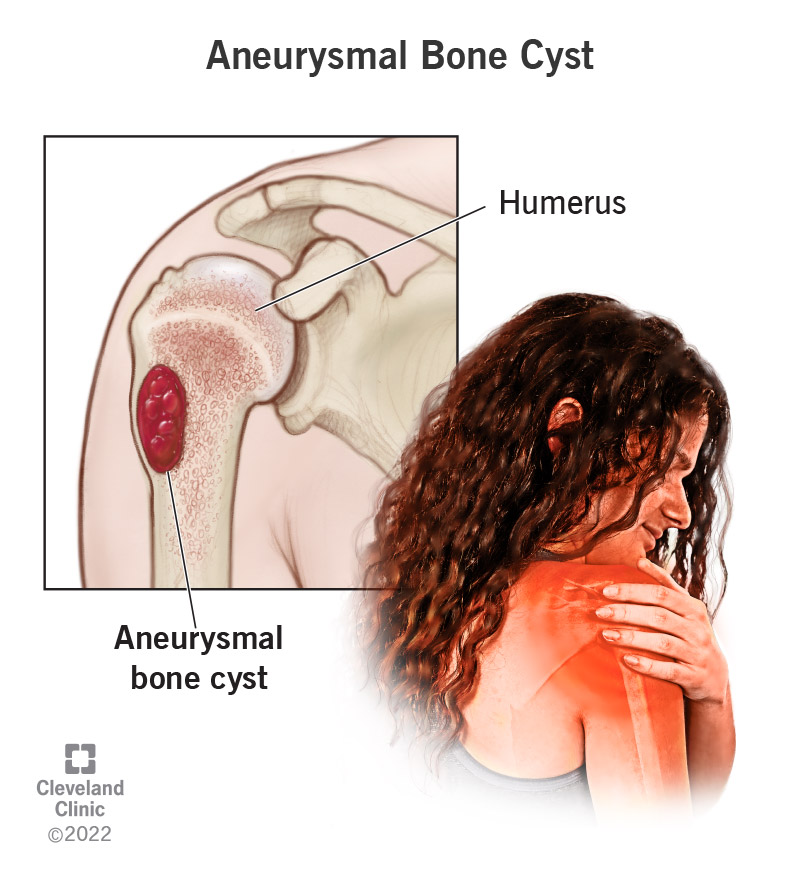Aneurysmal bone cysts (ABCs) are rare, noncancerous bone tumors that can develop in the long bones of your arms and legs and your spine. The tumor may look like a lump. This condition typically affects children and young adults aged 20 and younger. The tumors can grow quickly and become large. Treatment includes surgery to remove the tumor.
Advertisement
Cleveland Clinic is a non-profit academic medical center. Advertising on our site helps support our mission. We do not endorse non-Cleveland Clinic products or services. Policy

An aneurysmal bone cyst (ABC) is a benign (noncancerous) tumor in your bones. The tumor contains tiny cysts filled with blood. Aneurysmal (pronounced “an-yuh-riz-mahl”) refers to a bulge in your blood vessel wall. Cyst refers to fluid-filled cavities.
Advertisement
Cleveland Clinic is a non-profit academic medical center. Advertising on our site helps support our mission. We do not endorse non-Cleveland Clinic products or services. Policy
Aneurysmal bone cysts are rare. They make up just a small percentage of all bone tumors, which are rare themselves. The condition usually affects children and young adults under 20.
The tumors can develop in any bone. But the most common locations are in your:
There are two types of aneurysmal bone cysts: primary and secondary. A primary cyst develops on its own. A secondary cyst is when you have a different type of bone tumor that leads to an aneurysmal bone cyst.
Bone conditions and bone cancer that can cause secondary aneurysmal bone cysts include:
Common symptoms are changes in your arm, leg, pelvis or spine. Those changes may include:
An ABC on your spine that presses on your spinal nerves may cause:
Experts don’t know the exact cause. Possible causes could be:
Advertisement
The condition may keep your child’s bones from growing as they should. That may mean your child’s arm or leg bones may be shorter than their other arm or leg.
An aneurysmal bone cyst can cause a bone fracture if the tumor grows large enough to weaken your bones.
A healthcare provider will do a physical examination. They’ll examine any noticeable lumps on your bones. They may do imaging tests like:
Your provider may do a biopsy to get tissue samples from the tumor. A medical pathologist will look at the tissue under a microscope. They’ll check for signs that the tumor is cancerous.
The most common treatment is curettage. In curettage, an orthopaedic surgeon makes an incision in the area where the tumor is located. They open the tumor and remove the cysts and the lining of the tumor. They may use bone graft from a donor or another area of your body to refill the area where the tumor was.
Nonsurgical treatments include:
Recovery time for you or your child will depend on the treatment your provider uses. For example, it may take three to six months for your bone to heal after curettage. Ask your provider what you can expect as you or your child recover from surgery.
An aneurysmal bone cyst can come back (recur) after treatment. You should contact your provider if you notice changes like a new lump or pain in the area where you had treatment.
Aneurysmal bone cysts are highly treatable. But they come back in 1 in 5 people. Recurrence is most common within the first year after treatment.
Lumps are common. You or your child can get one from bumping into a door or running into any hard object. But a lump that doesn’t go away and gets bigger may be a symptom of an aneurysmal bone cyst (ABC). This is a rare disease that affects kids and young adults. You may be relieved to learn that an ABC isn’t a type of bone cancer. But the condition can lead to serious issues like a broken bone. Talk to a healthcare provider if you or your child have a lump that lingers or grows.
Advertisement
From sudden injuries to chronic conditions, Cleveland Clinic’s orthopaedic providers can guide you through testing, treatment and beyond.

Last reviewed on 04/20/2025.
Learn more about the Health Library and our editorial process.